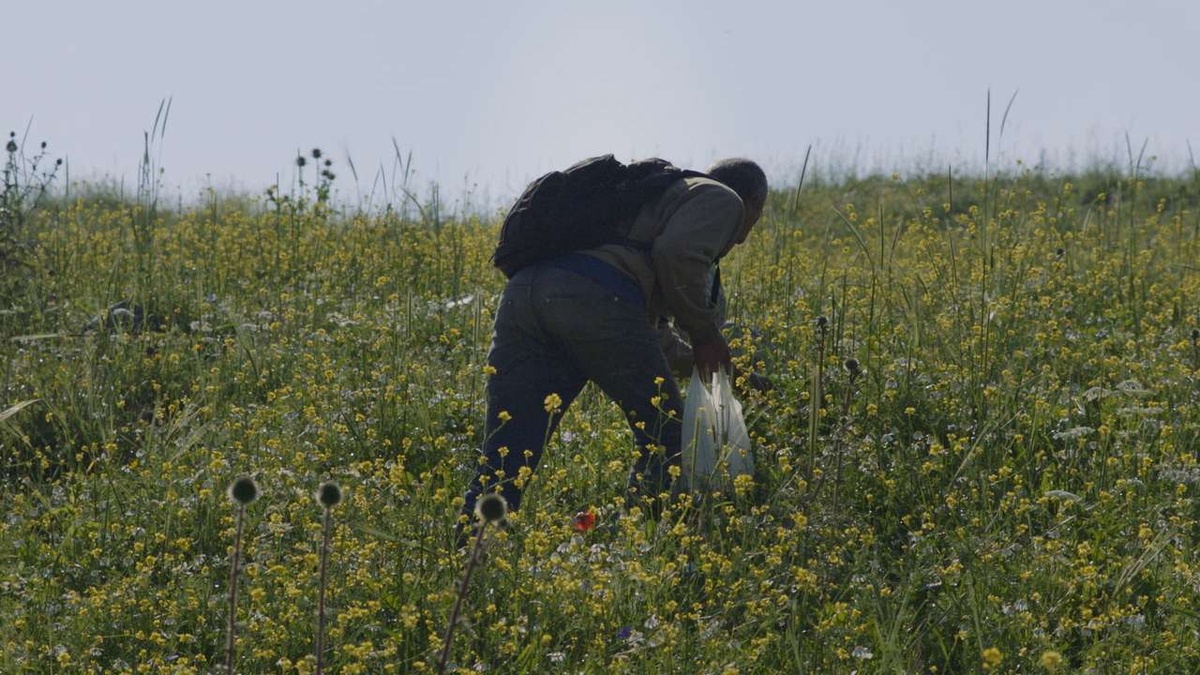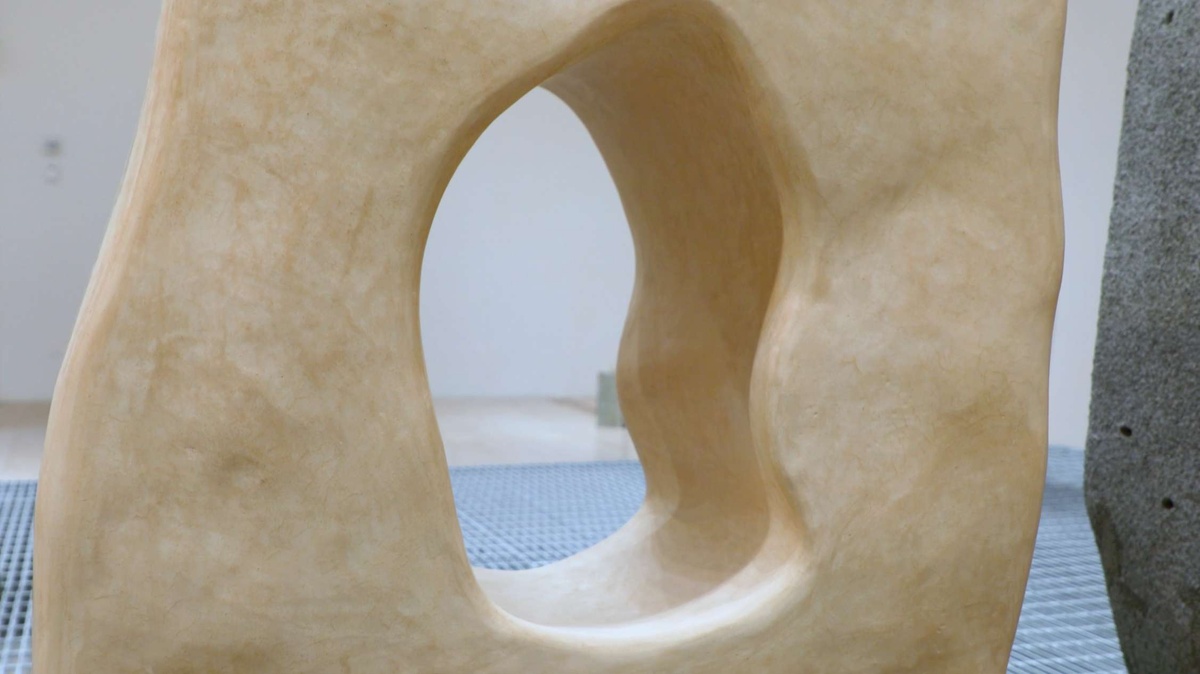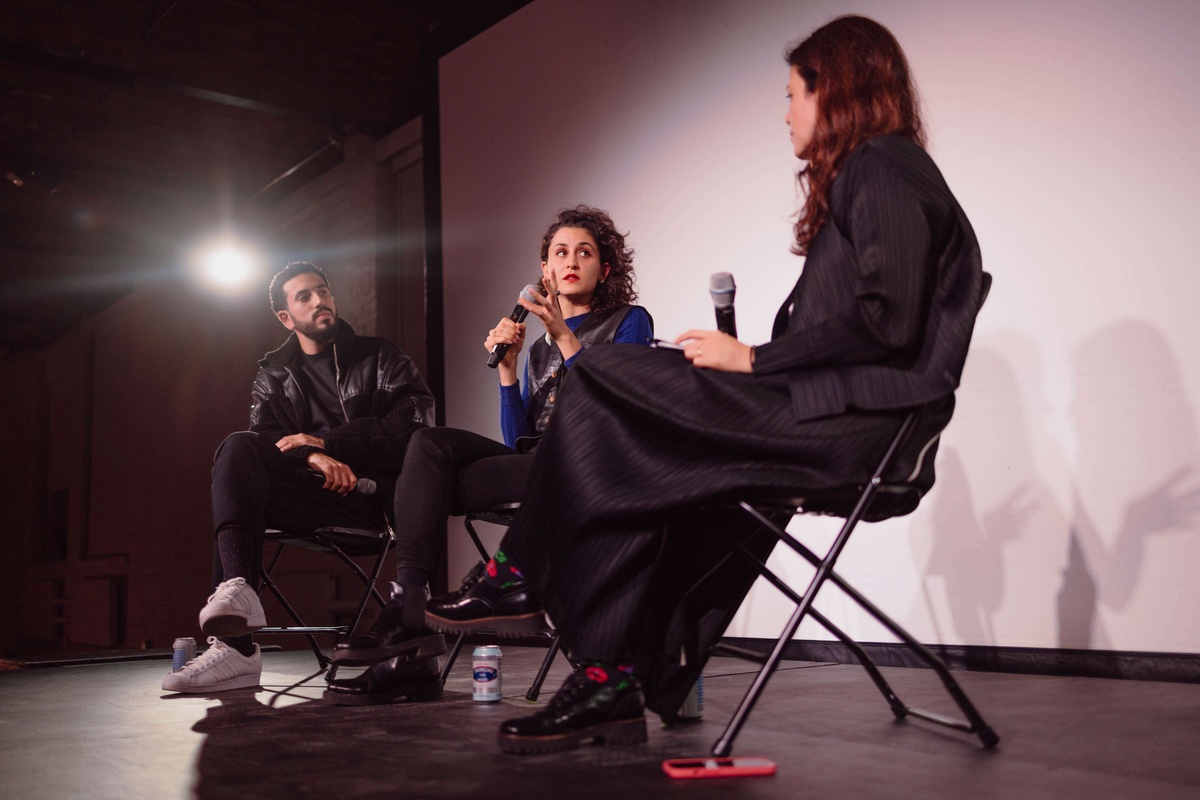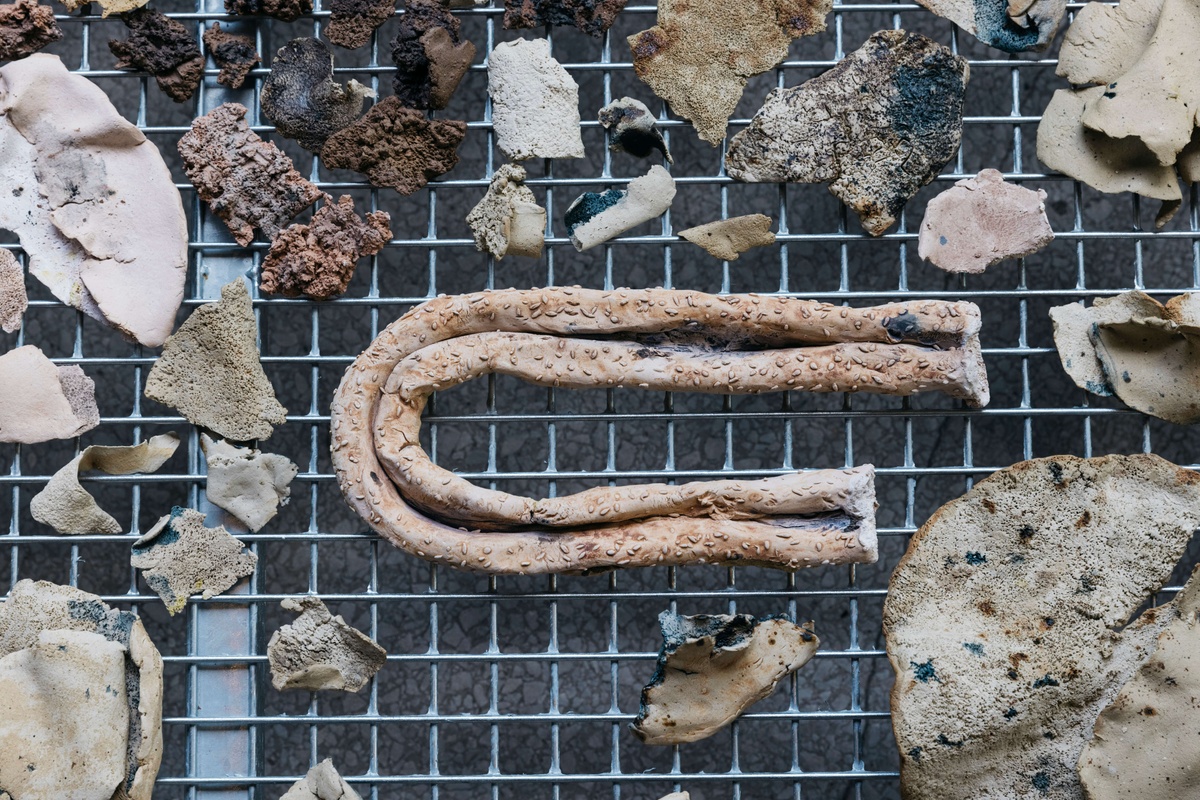Subject: We come out to meet you
- Writing
- Audio
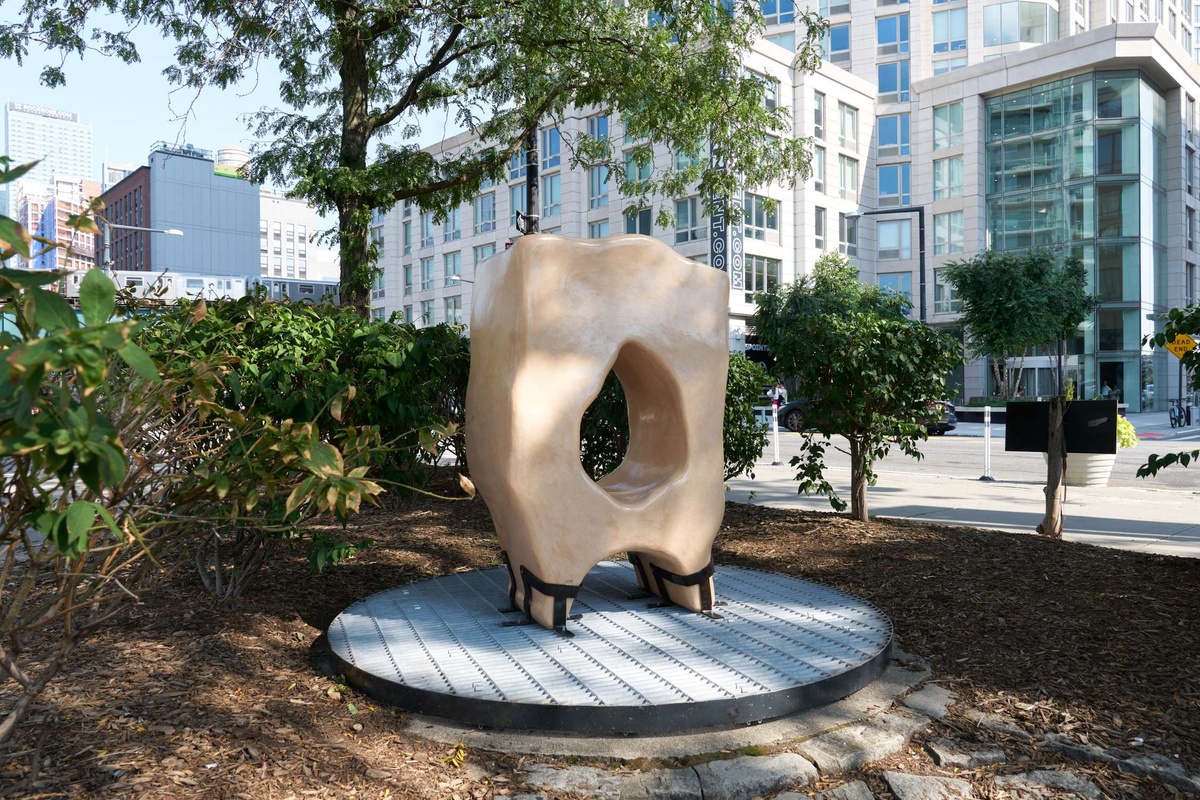
This text accompanies Jumana Manna’s Middle Ghost (2022), on view in the public plaza outside of MoMA PS1’s main entrance. It takes the form of a letter to the artist from the writer Rana Issa, a friend of Manna’s. The text is read by writer Mirene Arsanios.
Extending Manna’s exhibition at MoMA PS1 into the cityscape, Middle Ghost marks the first public artwork organized by PS1 in the public plaza, presented in collaboration with NYC Parks’ Art in the Parks program.
Subject: We come out to meet you
Subject: We come out to meet you
Dear Jumana,
Your new sculptures are so playful and ghostlike. They carry the scars of their dispossession with singular finish. They carry so much of our longing for a land untethered by capital’s alienating violence. I cannot help but see them with the eyes of a Beiruti who is witnessing the total collapse of her city and country. Despite the difference in scale and political value, those khabyas are comparable to the silos that were destroyed by the port blast that took place in Lebanon in 2020. Both those khabyas and the silos in Lebanon are types of granaries that have become ghosts. What ruined them was the dynamics of colonial capital and modernity that began many decades ago, before our parents were even born. Look at Lebanon, its silos were part of a modernizing state project. Today the disfigured granaries stand as monoliths accusing the state of gross incompetence. The khabyas too, accuse.
Khabyas are vessels that preserve grain. They are usually kept underground in the house, in the cool and dark recesses of cellar pantries. They are hardly seen by a house guest; you have brought them out into the light. When I saw them, I recalled a sentence that James Baldwin said in one of his TV interviews back in 1968: “All your buried corpses now begin to speak.”Now, here is one khabya standing outside, exposed to the elements on a bustling New York pedestrian crossing. This khabya is separated from the family of khabyas snugly kept inside the museum walls. Quizzically there, misunderstood by many passersby, this khabya is a haunting specter. Its stomach is hollowed out and will never carry grain. It has come in its decrepit form to haunt the city again, rising from oblivion. Oppressed subjects often act in this way. They insist on the right to be present. They resist their repression and come out dressed in their destitute condition. “We come out,” writes the Syrian poet Riyad al-Saleh al-Hussein in one of his poems from 1984:
we come out to meet you we are neither evil nor polite we neither like violence nor do we hate birds we come out, out to meet you with our balconies and days that drop like flies with our damaged age with our damaged homes our damaged bodies our damaged dreams and our damaged fruit we come out, out to meet you we the citizens of the neutron age
In contrast to these fateful utterances, you choose soothing colors and present the ruined khabyas whimsically. The quirkiness of the shapes and the color palette emphasize their libidinal energy, their erotic joy. These specters come out to meet us ready to participate fully in the vivid world of the living. When those vessels speak, they do not do so like Cassandra of Troy, but like jester figures. This whimsy that drives your work has nurtured our friendship. Our discussions about the relationship of art to politics that many times have moved to examine how lightness and laughter can be effective weapons against oppression. You make time palpable. Time is present in how you choose to represent decay and ruination in the broken form of the khabya. Their disrepair is the result of the dearth of agrarian sustenance, brought about by the violence of land dispossession. The farmers became construction workers.
The leisurely postures of the khabyas are politically significant in how they signal the importance of play. Leisure is a right that has been turned into privilege. Time has been stolen from so many people. The oppressed are exploited in a political economy of labor alienation and unemployment. If they are unemployed, the anxiety and lethargy eat at their souls and at their family relations. If they work, they spend whatever is left of their day reacting to their exploitation, in anger and resentment, with failing bodies and sinking spirits. If they still have any energy left, they resist. Sometimes their resistance is channeled artistically, sometimes their revolutions move mountains. And many times they despair, until they forge time to resist all over again. A whimsical aesthetic recuperates the joy in leisure as a right that we desire.
This relaxed approach to time is traditionally associated with the bourgeoisie, not because leisure belongs to them, but because they have appropriated it for themselves by robbing others of their time. I wonder if the craftsmen you worked with to bring the khabyas into being in Marrakesh get moments of leisure from their labor in today’s economy.
You re-present a form so traditional as the khabya in such a playful style. This representation bifurcates the past and attends to what persists from the past in the present. What is no longer contemporary in the khabya is its use value as an essential tool of food preservation in an economy that has been destroyed. This value will not come back and cannot gratify the needs of our stressed environmental present. In that sense, the khabya is a dead object from a tradition that has been rendered obsolete. But the pastness stops here, for the khabya persists as ruined tradition, the tradition of refusing a wrongful death motivated by greed and shortsightedness. Their presence today amongst us, as sculptures, is an aesthetic assertion of their right to life qua life, without any need to justify value or use to anyone.
The strong ruination motif critiques the dominance of romantic nostalgias of land typical of bourgeois aesthetics. Nostalgia labors to cover up how profitable our present moment is. Nostalgia of land reinforces our present distance from the dirt and toil of the past to hide from our own eyes how well adjusted we have become in the urban rat race. The nostalgic subject fixes the agrarian world in the past and misses the opportunity to apprehend its persistent vitality in the present and for our future survival.
In those sculptures, ruination functions as a prism that brings into focus many urgent concerns. The khabyas acquire their representative force by becoming prisms of ruination, where people and land fold into one another to desire a break from exploitation, a moment of reverie that would energize the right to squander one’s own time, lie in the earth and be useless—for being useful under settler colonial capitalism is death itself, and oblivion. As representations of dilapidated vessels that preserved food for a household, the khabya sculptures intervene in what we know today as the problem of food security, an accelerated problem that has come to the forefront of our global consciousness with the ongoing war in the Ukraine.
Khabyas belong to a different economy of food production. The wise farmers that depended on them stored grain and accumulated food items for the sake of mitigating failed crops in the future.Some scientists like to point to the Levant as the seat of the idea of capital because of this accumulative far-sightedness. They claim that today’s financial bank found its inspiration in the granaries that were prevalent in Mesopotamia. Those people tend to forget that the accumulation of grain is not like the accumulation of money that rich people practice these days, but to secure food when the land is less giving. Unlike capital’s temporalities of progress that estrange people from nature’s cycles, these khabyas are acts of submission to the cyclical temporalities of seasons of death and regeneration.
I did not know about those khabyas before you sent me pictures. Although you confirm that such khabyas were spread out across the Levant, North Africa, and with variations across much of the world, I find it significant that you stumbled upon them in Palestine. The context thickens the semantics of ruination that they carry on their bodies. The present destruction is the result of two processes of violence: Palestinian villages were destroyed either by colonial settlers or because they could not withstand the modernization that demoted Palestinian agrarian economies for the gains of urban affluence. The khabyas that inspired these sculptures are in the West Bank of the Jordan river, in the area that Israel annexed in 1967. Their current ruination there testifies to the blanket neglect of agrarian life in Palestine and the transformation of land-owning farmers into dispossessed workers.
The Mojave poet Natalie Diaz writes persuasively about the relation between land and body in a beautiful poem she titles “The First Body is the Water.” I remember that day when I escaped COVID restrictions in Oslo to be with you in COVID lockdown in Berlin and how we sat on your sofa peering over the book that carried this poem. We read it three times, and marveled at the exquisite logic of her poetics. The Mojave phrase that is the pretext of the poem, like your khabyas, resists its taming by translation. ‘Aha Makavch ithuum. In the poem, Diaz proposes a translation that is not a translation but instead an aesthetic complication of this phrase, challenging any attempt at its domestication in English. Likewise, your treatment of the khabyas maintains some of the mysteries of those khabyas. We have not told all what we know about them; we have kept some of their stories deeply buried in their chambers.
Stories that perhaps will sprout another time.
Your friend,
Rana
Sep 20, 2022 (6:00PM)
Text by Rana Issa.
Rana Issa writes in a number of genres and languages and has occupied leadership roles in various aspects of cultural production. She is the artistic director of Masahat.no and makes a living as a precarious member of the faculty of University of Oslo. She is the recipient of the National Endowment for the Arts award with Suneela Mubayi for her ongoing translation of 19th century author Ahmad Faris al-Shidyaq’s travelogue to Europe, Tickets to London and Paris by the Remarkable Ahmad Fares. Her book The Modern Arabic Bible is forthcoming in October with Edinburgh University Press. She lives and works in Oslo.
Read by Mirene Arsanios.
Mirene Arsanios is the author of The Autobiography of a Language (Futurepoem, 2022), Notes on Mother Tongues (UDP, 2019) and the short story collection, The City Outside the Sentence (Ashkal Alwan, 2015). She has contributed essays and short stories to e-flux journal, Vida, The Brooklyn Rail, LitHub, and Guernica, among others. She lives and works in Brooklyn.
